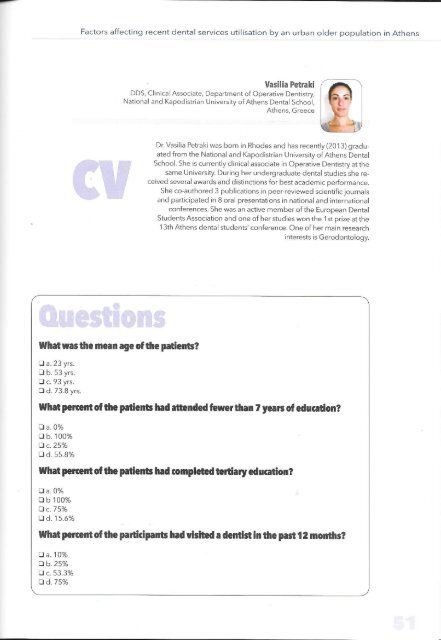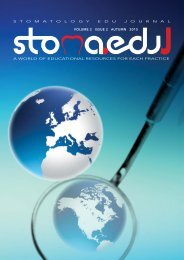STOMATOLOGY EDU JOURNAL 1-2014
Create successful ePaper yourself
Turn your PDF publications into a flip-book with our unique Google optimized e-Paper software.
overdenture<br />
Conclusions<br />
A dentist should be able to control and detect<br />
occlusal alterations produced by a non-equilibrated<br />
rehabilitation using the most correct methods. The<br />
method used in the present investigation allows<br />
a static evaluation of occlusion and can detect<br />
mandibular torsions and alterations between<br />
the two sides that cannot be controlled only with<br />
qualitative or purely morphological methods<br />
(articulation paper).<br />
The present surface EMG analysis of a static<br />
(clenching) task showed that the analyzed<br />
prostheses need stable dental contacts between<br />
the opposing dental arches.<br />
This functional condition could be protective<br />
for full-mouth prosthetic resin complications over<br />
implants. It should be underlined that the simplicity<br />
of the current tests with a minimal effort could<br />
provide useful clinical information for the day-today<br />
clinical practice.<br />
Bibliography<br />
1. Ferrario VF, Sforza C, Colombo A, Ciusa V. An electromyographic<br />
investigation of masticatory muscles symmetry in normo-occlusion<br />
subjects. J Oral Rehabil. 2000;27(1):33-40.<br />
2. De Felício CM, Sidequersky FV, Tartaglia GM, Sforza C.<br />
Electromyographic standardized indices in healthy Brazilian young<br />
adults and data reproducibility. J Oral Rehabil. 2009;36(8):577-583.<br />
3. De Felício CM, Ferreira CL, Medeiros AP, Rodrigues Da Silva<br />
MA, Tartaglia GM, Sforza C. Electromyographic indices, orofacial<br />
myofunctional status and temporomandibular disorders severity:<br />
A correlation study. J Electromyogr Kinesiol. 2012;22(2):266-272.<br />
4. Ferrario VF, Sforza C, Serrao G, Colombo A, Schmitz JH. The<br />
effects of a single intercuspal interference on electromyographic<br />
characteristics of human masticatory muscles during maximal<br />
voluntary teeth clenching. Cranio. 1999;17(3):184-188.<br />
5. Tartaglia GM, Testori T, Pallavera A, Marelli B, Sforza C. Electromyographic<br />
analysis of masticatory and neck muscles in subjects with natural<br />
dentition, teeth-supported and implant-supported prostheses. Clin<br />
Oral Implants Res. 2008;19(10):1081-1088.<br />
6. Ferrario VF, Tartaglia GM, Galletta A, Grassi GP, Sforza C. The<br />
influence of occlusion on jaw and neck muscle activity: a surface<br />
EMG study in healthy young adults. J Oral Rehabil. 2006;33(5):341-<br />
348.<br />
7. Ferrario VF, Tartaglia GM, Maglione M, Simion M, Sforza C.<br />
Neuromuscular coordination of masticatory muscles in subjects<br />
with two types of implant-supported prostheses. Clin Oral Implants<br />
Res. 2004;15(2):219-225.<br />
8. Jacobs R, Van Steenerghe D, Naert I. Masseter muscle fatigue<br />
before and after rehabilitation with implant-supported prostheses.<br />
J Prosthet Dent. 1995;73(3):284-289.<br />
9. Moriya S, Notani K, Murata A, Inoue N, Miura H. Analysis of<br />
moment structures for assessing relationships among perceived<br />
chewing ability, dentition status, muscle strength, and balance<br />
in community-dwelling older adults. Gerodontology. 2012. doi:<br />
10.1111/ger.12036.<br />
10. Grosdent S, O’Thanh R, Domken O, Lamy M, Croisier JL. Dental<br />
occlusion influences knee muscular performances in asymptomatic<br />
females. J Strength Cond Res. <strong>2014</strong>;28(2):492-498.<br />
11. Van Kampen FM, van der Bilt A, Cune MS, Bosman F. The<br />
influence of various attachment types in mandibular implantretained<br />
overdentures on maximum bite force and EMG. J Dent<br />
Res. 2002;81(3):170-173.<br />
12. Al-Omiri M, Hantash RA, Al-Wahadni A. Satisfaction with dental<br />
implants: a literature review. Implant Dent. 2005;14(4):399-406.<br />
13. Flanagan D. An overview of complete artificial fixed dentition<br />
supported by endosseous implants. Artif Organs. 2005;29(1):73-<br />
81.<br />
14. Feine JS, Lund JP. Measuring chewing ability in randomized<br />
controlled trials with edentulous populations wearing implant<br />
prostheses. J Oral Rehabil. 2006;33(4):301-308.<br />
15. Farella M, Bakke M, Michelotti A, Rapuano A, Martina R.<br />
Masseter thickness, endurance and exercise-induced pain in<br />
subjects with different vertical craniofacial morphology. Eur J<br />
Oral Sci. 2003; 111:183–8. Eur J Oral Sci. 2003;111(3):183-<br />
188.<br />
16. Garcia-Morales P, Buschang PH, Throckmorton GS, English<br />
JD. Maximum bite force, muscle efficiency and mechanical<br />
advantage in children with vertical growth patterns. Eur J Orthod.<br />
2003;25(3):265-272.<br />
17. Christensen LV, Rassouli NM. Experimental occlusal<br />
interferences. Part II. Masseteric EMG responses to an intercuspal<br />
interference. J Oral Rehabil. 1995; 22:521-531. J Oral Rehabil.<br />
1995;22(7):521-531.<br />
18. Karlsson S, Cho S-A, Carlsson GE. Changes in mandibular<br />
masticatory movements after insertion of nonworking-side<br />
interference. J Craniomandib Disord. 1992;6(3):177-183.<br />
19. Rassouli NM, Christensen LV. Experimental occlusal<br />
interferences. Part III. Mandibular rotations induced by a rigid<br />
interference. J Oral Rehabil. 1995;22(10):781-789.<br />
20. Baba K, Ai M, Mizutani H, Enosawa S. Influence of experimental<br />
occlusal discrepancy on masticatory muscle activity during<br />
clenching. J Oral Rehabil. 1996;23(1):55-60.<br />
21. Fontijn-Tekamp FA, Slagter AP, van’t Hof MA, Geertman ME, Kalk<br />
W. Bite forces with mandibular implant-retained overdentures. J<br />
Dent Res. 1998;77(10):1832-1839.<br />
46 Stoma.eduJ (<strong>2014</strong>) 1 (1)



